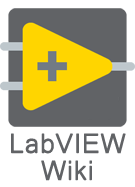Symbolic path
A symbolic path (aka. pseudo path) is a placeholder that represents one or more well-known locations in LabVIEW. When specifying a path to a file or folder inside a well-known location, rather than specifying the absolute path, the path is specified relative to the symbolic path. When accessing the path, it is resolved to the actual location, which may be different between machines, platforms, targets, and versions of LabVIEW.
A VI that uses "<vilib>:\a.vi" may resolve to "<labview>\vi.lib\a.vi" when loaded for a desktop target, and "<labview>\vi.lib\fpga\a.vi" when loaded for a FPGA target.
A symbolic path can also refer to multiple locations that overlay each other as if they were a single directory. If a file with the same name exists in multiple directories, the first file found is used. The order in which directories are scanned may vary and can be determined using the Build And Resolve Symbolic Path VI with "symbolic path id" set to "<libdir>".
Syntax
Symbolic paths are used similar to drive letters in Windows. For example, "<userlib>:\myfile.txt" specifies a file named myfile.txt in the user.lib directory.
Usage
LabVIEW uses symbolic paths internally to store paths to files and folders. For example, the lvproj file format stores paths to files using symbolic paths. Symbolic paths are also useful for VI Scripting.
Resolving symbolic paths
In order to access the actual path that a symbolic path represents, it must be resolved. In LabVIEW 2023 Q3 and later, the Build And Resolve Symbolic Path VI should be used. In earlier versions from LabVIEW 2015 and later, the Resolve Symbolic Path VI should be used. For even earlier versions, the private Resolve Symbolic Path method, which is deprecated since LabVIEW 8.5, can be used.
See also
External links
- Resolving Symbolic Paths (LAVA)
- Resolution of Pseudopaths per Target (NI forums)
